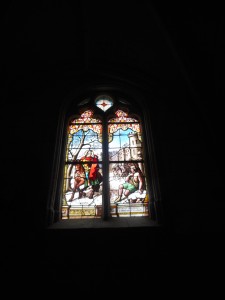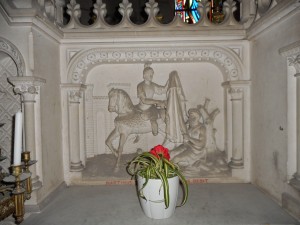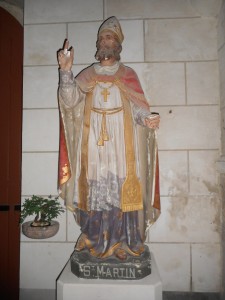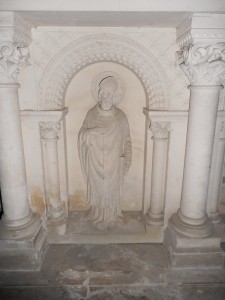Le mur du transept nord est le seul vestige de l’église primitive, bâtie sur un plan en croix latine. Le chevet de l’inter transept date du XIIe siècle, ainsi que l’abside voûté en cul de four et éclairée par trois fenêtres en plein cintre. Deux chapelles du XVIe siècle encadrent le chœur. La base du clocher carré qui surmonte la croisée du transept est romane ; la partie haute a été refaite en 1740. Au XIXe siècle, l’église s’est enrichie de vitraux, dont saint Martin représenté sur le premier vitrail du côté sud. L’église abrite un bas-relief et un vitrail de la charité de saint Martin, un bas-relief et une statue de saint Martin évêque.
Le vitrail de la charité de saint Martin se trouve dans la nef de l’église Saint-Martin de Mosnes. Il fut réalisé par Fournier, à Tours, en 1894, donné à la paroisse par monsieur et madame Vernon, en souvenir d’un vœu exaucé, comme cela est écrit en bas du vitrail.
Saint Martin est auréolé. Il tient son manteau dans la main gauche qu’il coupe de la main droite pour le donner à un pauvre, assis sur le sol. Le pauvre porte du bois sur le dos. En arrière plan on distingue d’autre cavalier sortant de l’enceinte de la vile. La scène se passe en hiver, on peu voir de la neige sur le sol et les empreintes des sabots qui y sont inscrites.
Une charité de saint Martin se trouve au deuxième niveau, à droite, de l’autel de l’église. Saint Martin est présenté en soldat romain, à cheval, en train ce coupe son manteau. Le mendiant est assis par terre et touche le bout du manteau.
Une statue de saint Martin se situe à la droite de l’entrée de l’église. Il est représenté en évêque, mitré, avec une cape rouge, une étole dorée, une dalmatique blanche et une aube bleue. Il tenait un objet qui a disparu dans la main gauche et la main droite fait le geste de bénédiction. De l’autre côté de la porte se trouve une statue de saint Perpet.
Saint Martin est présenté en évêque dans une niche de l’autel de l’église. Il est le pendant d’une statue de saint Perpet.
L’église est classée Monument Historique par arrêté du 20 janvier 1966 : PA00097883
The wall of the northern transept is the only remnant of the original church, built on a Latin cross plan. The chevet of the inter-transept dates from the 12th century, as well as the apse with a barrel vault and lit by three round-headed windows. Two 16th century chapels frame the choir. The base of the square bell tower which surmounts the transept crossing is Romanesque; the upper part was rebuilt in 1740. In the 19th century, the church was enriched with stained glass windows, including Saint Martin in the first window on the south side. The church has a bas-relief and a stained glass window of St Martin’s charity, a bas-relief and a statue of St Martin the bishop.
The stained glass window of the charity of Saint Martin is located in the nave of the church of Saint Martin in Mosnes. It was made by Fournier, in Tours, in 1894, given to the parish by Mr and Mrs Vernon, in memory of a granted vow, as it is written at the bottom of the window.
Saint Martin is haloed. He is holding his cloak in his left hand, which he is cutting with his right hand to give to a poor man sitting on the ground. The poor man is carrying wood on his back. In the background we can see another rider coming out of the city walls. The scene takes place in winter, with snow on the ground and hoofprints on the ground.
A charity of St. Martin can be found on the second level, to the right, of the church’s altar. Saint Martin is shown as a Roman soldier, on horseback, cutting his cloak. The beggar is sitting on the ground and touching the end of the cloak.
A statue of St Martin is located to the right of the church entrance. He is depicted as a bishop, mitred, with a red cloak, a golden stole, a white dalmatic and a blue alb. He was holding an object that has disappeared in his left hand and his right hand is making the gesture of blessing. On the other side of the door is a statue of Saint Perpet.
Saint Martin is shown as a bishop in a niche on the church altar. He is the counterpart of a statue of Saint Perpet.
The church is classified as a Historic Monument by decree of 20 January 1966: PA00097883

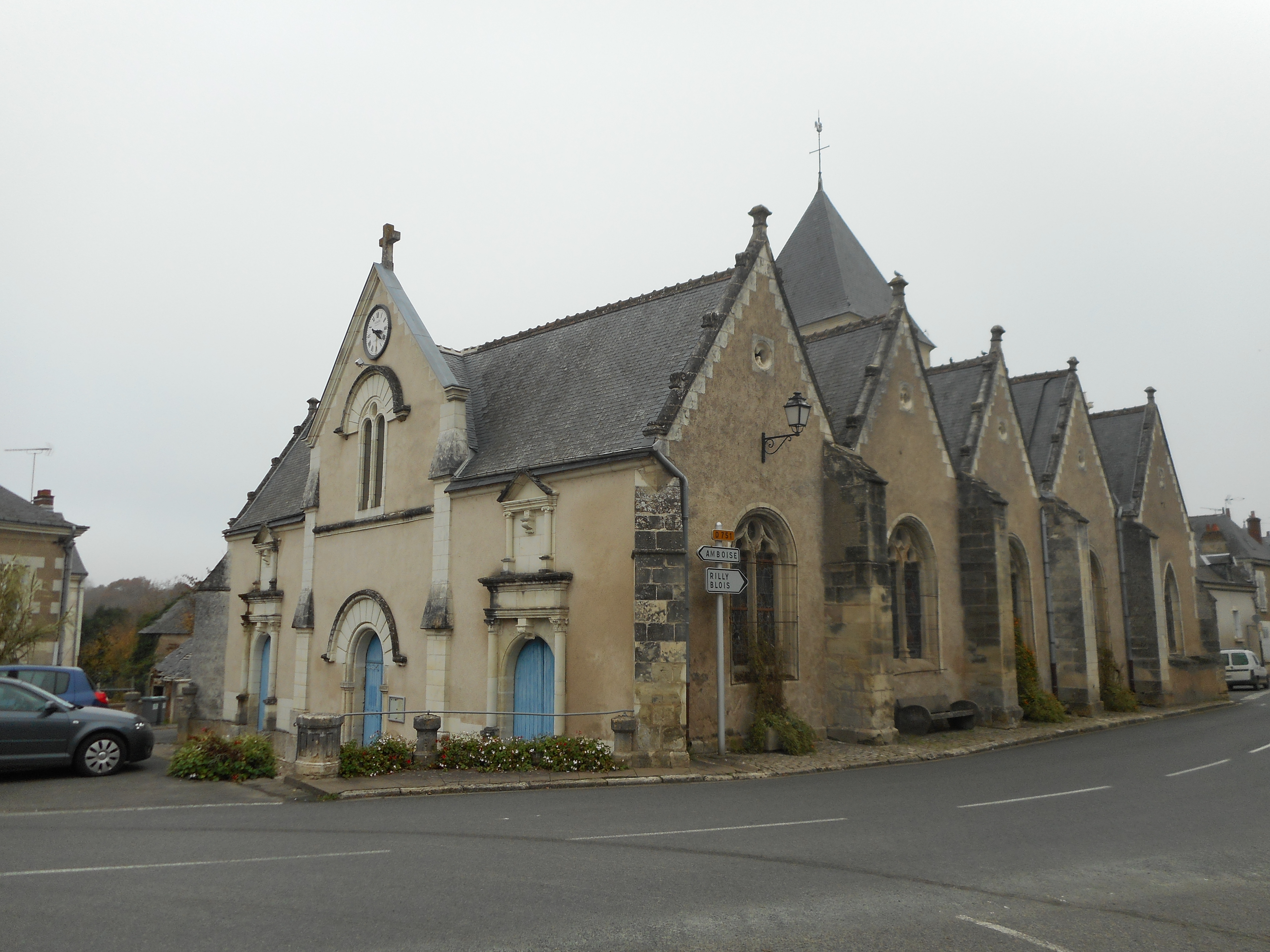 "/>
"/>
